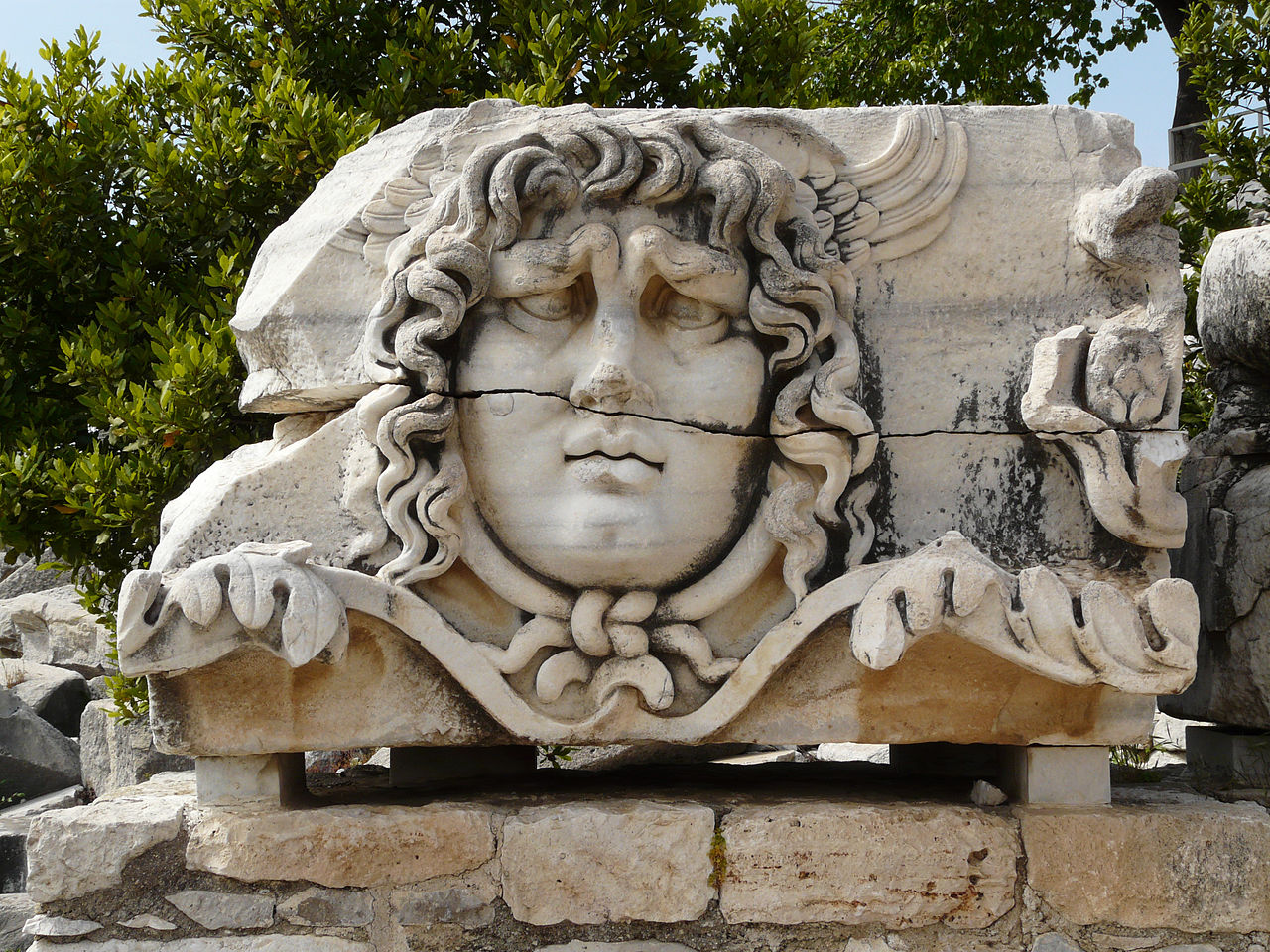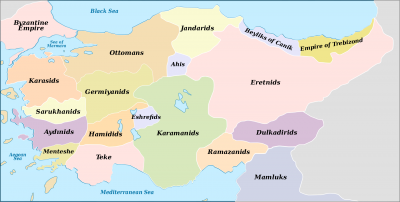Toponym
The original Greek name of the sancak’s ancient administrative was Tralleis (Grk.: Τράλλεις; latinized: Tralles).
The name of the province, the sancak, the kaza and the sancak’s administrative seat of Aydın derives from the principality of the Aydınoğulları, who ruled the region before the Ottomans (in Greek: Αϊδίνιο – Aidinio). Aydın is a Turkish male and female given name meaning ‘bright’, ‘clear’ or ‘educated’. The first name also occurs very often as a family name.
Administration
Aydın became part of Anatolia Province of the Ottoman Empire until 1827, when it became the seat of its own eyalet under its own name, constituted among other reasons to respond to the prevalent unrest in the region, as exemplified by Atçalı Kel Mehmet Rebellion (1829–1830). The seat was moved to Smyrna in the 1840s and with the abolition of eyalets under the administrative reforms of 1864, Aydın became a sancak of the vilayet of the same name, with its seat still in Smyrna, which had outgrown Aydın city in size as it became a booming port of international trade.
In the late 19th century, the sancak of Aydın comprised the five kazas Aydın, Nazilli, Bozdoğan, Söke and Çine.
Greek Orthodox Population
Ecclesiastically, the Greek Orthodox population of the sancak of Aydın belonged to the Diocese of Helioupolis, consisting of 50 communities with 54,249 Greek Orthodox Christians[1] and to the Diocese of Aneon (Sokia; Trk: Söke), numbering eighteen communities and 31,036 Greek Orthodox inhabitants.[2]

Destruction
Diocese of Helioupolis
June 1914: Massive flight, deportation, forced labor, insecurity
“The first manifestation of the persecution of the Greek element of this Diocese [of Helioupolis] (…) was the opening of the boycott. It started at Aktche [Akçe], and soon spread all over the Diocese, largely due to the energy displayed by the Government officials. Pamphlets were distributed by the Mudir of Pyrghi (near Odemitch [Ödemiş; Grk.: Οδεμήσιο – Odemísio] to the Turkish Muhtars, imploring the Moslems in the name of the Prophet to start, at the first signal given, plundering and massacring the Christians.
The sub-governor of Odemitch issued an order by the town crier to the effect that henceforth tailors and merchants were strictly prohibited to manufacture for, or sell clothes to the Moslems. Whosoever transgressed this order would be fined Ltq. 5; and in case of a repetition of the act, would be beaten, imprisoned, and finally exiled.
Side by side with the boycott were the assassinations committed unceasingly. In every Turkish village a certain number of miscreants were appointed, whose work was to annihilate the Christians by attacking and plundering them throughout the Communities.
The village of Aktche suffered from the aggression of one of these bands. On the 10th of September, 1915, Turks penetrated into this locality, blockaded its exits, and plundered the shops of the notables George Sfedjopoulo, Hadji Petro Broussali, George Christou Philippa Ktisti and Haralambo Savopoulo, whom they massacred on his own premises, after which they conducted the remaining four to the market of the village and shot them down.
These incessant atrocities, coupled with the taxation and extortion of money and goods, forced the population, especially the higher class, to abandon their fortunes in the hands of the marauding bands and seek refuge in Aidina [Aydın] and Smyrna, well pleased to save their lives and honour.
On the 6th June, 1914, Somaragda, Metropolitan of Helioupolis, wrote :
‘My Diocese continues to present a spectacle of desolation and distress. Besides the total economic ruin, occasioned by the boycott to the Christians through the destruction of their tobacco plantations, their fig and olive trees and their gardens, in fact of every means of subsistence, the rumours of the ravages committed in other communities have brought about such a feeling of despair amongst the Greek element that half the population of the Aidina and Thyra regions have these last few days emigrated to Smyrna in order to save their lives. It is impossible for me to describe the panic with which the Christians are stricken.
Although up to this moment not one of the communities has been completely evacuated, still this region has not been altogether un-affected by the European War. The Karia section was more especially violently persecuted owing to its position on the littoral (sea-coast).’
The majority of the inhabitants of : 1. KEFALOUKAS, 2. BAALA, 3. GUMUSLI, 4. ALICAUNASSUS, 5. KILIK, 6. MYLASSA, 7. KARAMACA, 8. TATSA-PETSA, 9. TALI- ANI, 10. YUKSEK-KOIM, 11. KOYOUDJAK and
- MADALIA, embarked on sailing vessels and took refuge in the adjacent islands. Later on, the notables of the aforesaid communities were arrested under various pretexts and thrown into prison. Finally in July, 1918, feigning to enforce the law upon defaulters, the order was given that the remaining Greek inhabitants of these communities as well as those of : 13. KOKINOHORI, 14. MASSAT, 15. YENI-PAZAR, and 16. KAUADJA-SOL, should be expelled and deported. Some few were sent to Mougla [Muğla], and the others exiled to some Turkish villages. The evacuated communities were completely destroyed, many of whose inhabitants died of fatigue, hunger, privations, illness, etc.
It would fill a whole volume if a detailed account of the massacres of the peaceful Christians of this Diocese were to be given, without of course, taking into account the innumerable deaths that took place among the Christian soldiers of the ‘Labour Corps’ through want of proper nourishment, and ill-treatment on the part of their officers.
Moslem brigands carried away Christian notables to the mountains and only let them free after having made them pay heavy ransoms. This danger prevented the Christians from attending to their work in the fields.
A few days ago, the following letter dated 14th June, 1914, was addressed to the Metropolitan of Helioupolis from Tatsis:
‘The local gendarmerie collected all the guns belonging to the Christians, and on the 9th of the month, at 4 p.m., the Turkish Muhtars of the village of Kar-keuy [Karaköy?] ‘tatsi district’ and other armed Turks surrounded the residence of one of the best Greek families here, broke into it, found the head of the family, beat him mercilessly, and took away his daughter sixteen years of age. Three of the gendarmes guarded the entrance of the house until the three others with their victim were out of sight. As the girl offered some resistance they tied her hands behind her back, and dragged her along to a place about ten minutes walk from the village. The chief of the brigands, a certain Zabit Bey, fifty years of age, fell on the poor girl, and was the first to brutally violate her. The others then followed suit. This lasted until morning, when they carried the girl in a fainting and half- naked condition close to her home, and ran away.’”[3]
